Abstract
New methods are needed to attract more interest to natural sciences among the public and young people. We established an underwater laboratory by placing cameras on an artificial reef (a sunken ferry) to create a new and inspiring way of teaching marine biology and showing science to the public. Here we describe the process and solutions to the technical challenges in designing the laboratory. Live-streaming from the underwater environment has great potential for teaching marine biology in new and exciting ways, and it could also be used more widely for stimulating interest among the general public in aquariums and museums.
1. Introduction
As part of the ongoing discussions about marine issues—such as plastic in the oceans, global warming, marine species extinction, and so forth—new and inspiring ways to present the oceans could be a way to generate more interest and awareness among the public. With 8750 km of coastline, the ocean is a substantial part of Denmark’s nature. Scientists, teachers, and communicators of the natural environment are, however, often challenged with engaging in communication and active learning about the oceans.
Part of the challenge may be that communicating and teaching about the marine environment in an exciting way due to its inaccessibility. Teaching can be difficult to make lively and engaging, especially if live marine animals cannot be used for logistical and economic reasons. Studies have shown a decreasing interest in natural sciences among young people [1,2] and although children start their life in the educational system with a high degree of motivation and interest in nature and science, they leave school with a low motivation and low interest in these subjects [3].
It is conceivable that part of the disinterest in natural sciences among school students could be due to use of traditional means of teaching [4] with a low degree of involvement in non-activating teaching methods. Therefore, new and innovative teaching methods are needed to spur student interest and fascination with natural science. One obvious topic to focus on to increase student interest in natural sciences is the underwater environment, as life beneath the surface has intrigued the public since the films by Jacques Cousteau in the 1950s and 60s, and more recently through a series of high quality nature film productions (e.g., BBC’s The Blue Planet). Simultaneously, news broadcasting often reports on topics such as overfishing and ocean pollution and plastic in the oceans. The ocean does not only provide healthy food and energy (through fishing, oil and gas drilling, and offshore wind farms) for a major part of the world’s population, but it also plays a key role in the current debate on global climate change.
Today, technology provides new and exciting possibilities of conveying the fascinating life below the surface of the sea. Underwater video live-stream has become a tool exploited at several sites around the world to raise public awareness of the underwater environment (e.g., Lovéncentret Kristineberg, Sweden; Monterey Bay Aquarium, USA; Great Barrier Reef Cam, Australia).
In 2014, an out-of-service ferry was intentionally sunken off the southern coast of Funen, primarily aimed at attracting divers to the area. During the first three years, nearly 15,000 dives have been made at the wreck. Until now, however, only divers have had the opportunity to observe the biological life at the wreck. Therefore, an ‘underwater laboratory’ was established enabling live-stream video from the wreck to the internet, so it could be used in teaching and communication activities about the ocean and to present the ongoing research on the artificial reef to the public. Live-stream video from the ferry was used for teaching activities at schools, and the effect on student interest in natural sciences, with special emphasis on marine biology, was evaluated with a questionnaire before and after the teaching. Here we describe the technical solutions used to obtain live-stream video from the sunken ferry.
2. Materials and Methods
The study location was an artificial reef created by the sunken ferry, ‘Aeroesund’ (Figure 1), located 550 m from the harbor of Ballen on the island of Funen, Denmark. The ferry was stripped from paint and other chemicals and intentionally sunk in October 2014 to provide an attraction for divers and to increase tourism in the area. The ferry is 55 m long, 13 m high, and sunken at 19 m water depth (Figure 2).

Figure 1.
Sensory scan (side-scan sonar image of the sunken ferry) of the sunken ferry. Both ends of the ferry lines are attached to a buoy on the surface. With permission from: SensorySurvey.
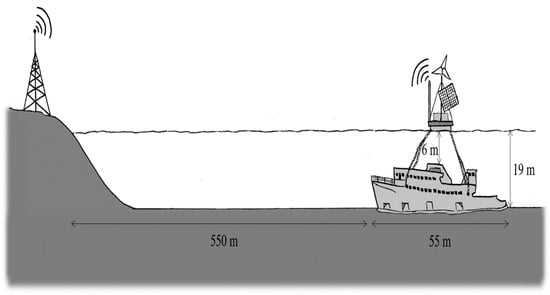
Figure 2.
The sunken ferry with the pontoon above, including windmill and solar cells to power the cameras and the mobile link to land. Drawing by Sara Ortiz.
A pontoon was built consisting of a 3.1 × 3.1 m wooden frame around four floating smaller pontoons (Figure 3) and attached to the sunken ferry with chains (four chains—each 20 m long, galvanized steel, thickness 16 mm; each link with dimensions: 150 mm length, 100 mm width outside and 68 mm inside).
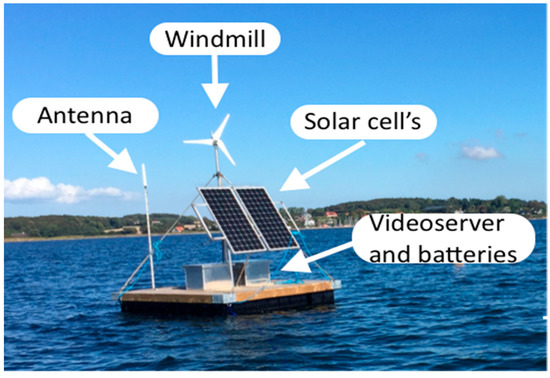
Figure 3.
The pontoon anchored at the ferry with four chains. On the pontoon; a mounted antenna, windmill, solar cells, video server, and batteries supplying electricity for the cameras and light sources on the ferry.
To prevent the chains from breaking due to changes in water depth during tides and winds, five extra meters secured a slack and prevented tension and a possible damage of the chains. The pontoon housed all the electronics and was connected by cables to three underwater video cameras with light sources mounted on the ferry and one in-air video camera monitoring the pontoon.
On the pontoon, two waterproof boxes housed the electronics, power supply controls, and batteries. Cables from video cameras and light sources were connected to the box containing a custom-built video server. The server was connected to a mobile phone link (supplied by Telenor, 1 TB broadband) and to a mobile phone antenna, attached at the end of a 5 m long carbon fiber mast (Figure 2).
The unit was powered by four batteries (Haze Gelled Electrolyte range model HZY 12-100, 12 V, 200 Ah). The batteries were charged by a windmill (Rutland 1200, 500 watts, diameter 1200 cm, producing 500 W at 15 m/s) placed on the pontoon on a 4 m long metal stick connected to a controller (Marlec, Corby, UK, Hybrid MPPT Charge Controller) and by two solar cells (Monocrystalline Solar Module JT195 Ab, 380 W, 1550 × 808 × 40 mm. Jetion Solar Europe, Ruggel, Liechtenstein) connected to a controller (Steca PR 3030. RS Components, Copenhagen, Denmark) (Figure 4).
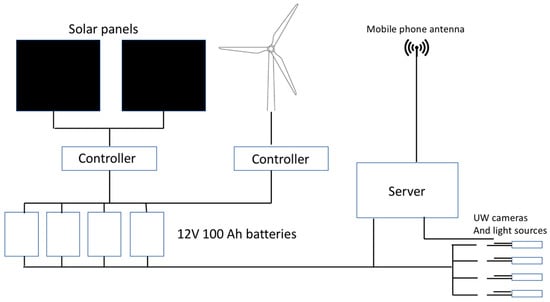
Figure 4.
Electronic diagram of the system.
The windmill and solar cells supplied electricity to the video server and cameras. From the video server, underwater video cables (LH Xtreame 1, diameter 7.5 mm, LH Camera 400-001. LH Camera, Fredericia, Denmark) were led down to the ferry and the three cameras (Divers Pro, underwater model pro fisheye, LH Camera 100-021, connected to the cable by 4-Pin Subconn micro connector. LH Camera, Fredericia, Denmark) combined with light sources (LED 1800, LH Camera 500-001, 1800 lumen). Cables were attached with cable ties to the chain about every 1 m. At the ship wreck, a couple of meters of slack was given before the cables were finally mounted on the wreck. Cameras and light sources were attached to the wreck by a custom-built holder (Figure 5).

Figure 5.
Setup of camera and light source on the sunken ferry.
The system is controllable via an app (SmartPSS) providing different options for e.g., switching lights on and off. The general public can access live-stream video from the ferry on the webpage www.sdu.dk/havet. The equipment on the pontoon was monitored via the live stream and by regular sailing trips to the pontoon to examine the setup for damages and abrasion.
3. Results
The system was connected online the 27 September 2016. Throughout the total number of days the system was installed at the ferry, it functioned 90% of the time. The cables attached to the ferry caused the largest problems in transmitting the video from the ferry (26 days out of order, 6 dives for repair, Table 1). These repairs demanded that all cables were dismounted from the ferry and repaired. The pontoon and its equipment (solar cells, windmill, video server, batteries) caused no major concerns, besides four days of unstable pictures, which was fixed by resetting the system. Table 1 shows the problems in the different parts of the system, and how the problems were solved.

Table 1.
Overview of the different parts of the system for live streaming and the observed problems the parts potentially have caused, number of days out of order, solution to the problem, number of dives used to repair, and future improvements.
The system was able to withstand winds of up till 16 m/s without any damage or technical problems. Figure 6 sums up 8311 observations of wind in the area around the ferry, measured by The Danish Meteorological Institute at station Sydfyns Flyveplads (number 06124) in the period 1 September 2016 to 15 August 2017.
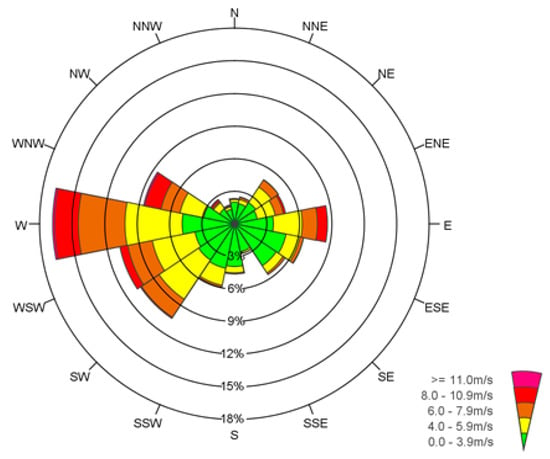
Figure 6.
Mean wind, maximum wind, and the direction of the wind, measured at the local station (Sydfyns Flyveplads, station number 612400) by The Danish Meteorological Institute from September 2016 to August 2017.
The quality of the video footage was very satisfactory also when used on large screens with projectors when teaching at schools; it allowed for a resolution down to a few mm. Large amounts of invertebrates of sizes from less than a cm to above 10 cm could be classified as well as a great variety of fish and shrimp of approximately 1–30 cm length passing by the cameras (Figure 7). The screen shots from the live cameras taken in October 2016 show a diver in the background and different animals in front, dominated by blue mussels (Mytilus edulis) and sea squirts (Ciona intestinalis). The three screenshots from June 2017 and July 2017 show a large variety of species including cod (Gadus morhua) and goldsinny wrasse (Ctenolabrus rupestris) observed in large numbers at the wreck.
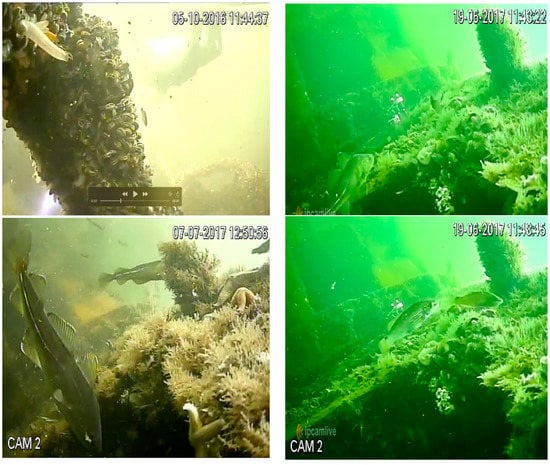
Figure 7.
Screen shots from the live-stream taken between May 2016 and July 2017.
4. Discussion
To increase the public’s understanding about oceans as well as their interest for research the use of live-streaming where ongoing research is presented on-line directly to the public could be one a way to proceed in the future. Live-streaming from ship wrecks, stone reefs, mussel farms, fish farms, fishing boats, aquariums, or transmitting live from/on animals (crabs, whales, seals, fish, etc.) in nature could work as tools to increase interest in the oceans. The system developed in this project has great potential for a wider public use such as in aquariums, museums, and on public web-sites. One such setup is built at the public aquarium Fjord&Bælt (Kerteminde, Denmark) where an exhibition shows a live-stream from the ferry and explains ocean challenges and the function of artificial reefs. Also, at the public aquarium, Øresundsakvariet (Helsingør, Denmark) a screen has been set up, presenting aquarium visitors with live-stream and video clip from the ferry. Both aquaria have observed large interest among guests in the live-stream (Tue Larsen and Michael Hansen, pers. comm.). Together, these two aquariums have >100,000 visitors annually, and the live-stream thus has the potential of boosting interest for marine sciences in a larger part of the Danish population.
In addition, a number of dive shops in Denmark show live-stream from the ferry to customers in the shops and use it to assess visibility at the sunken ferry when planning their dives. Denmark has more than 8000 registered SCUBA divers, of which many are organized in local and nationwide clubs. With the right education and information, they can act as ambassadors for the marine environment, further spreading their enthusiasm and know-how to the rest of the Danish population as well as to international divers and tourists in Denmark. The protection of the coastal environment is currently an important topic in the Danish political debate, as in many other countries. By educating and informing the citizens in an enthusiastic way, this may affect their view on the marine environment and thereby also affect politicians in taking appropriate actions based on both compassion and know-how when managing underwater habitats.
In general, the purpose-built system has been able to withstand the very demanding physical environment off the coasts of Denmark. The cables attached to the ferry caused the largest problems in transmitting the video from the ferry (26 days out of order, 6 dives for repair). These repairs demanded that all cables were dismounted from the ferry and repaired. For future projects like this, it would be preferable to be able to fix these on location.
As a future improvement, we suggest that the pontoon and the chains be moved away from the wreck and anchored since the chains can potentially damage the location. In this case, we have had challenges with the chains scrapping the wreck which also generated unwanted noise for divers and the animals on the reef.
The aim of this study has been to generate a new and inspiring possibility for the public to be a part of live research and in the future to use this platform to generate more interest in the oceans among young people. Many initiatives have been taken to reduce the high drop-out rates among STEM students (science, technology, engineering, and mathematics) and to support and develop student interest in, and understanding of, natural sciences. For biology, most of these initiatives focus on the wellbeing of students as well as teaching new and exciting subjects with traditional teaching methods. Predictions show that by 2025, despite increased admissions, Danish universities will be faced with a shortfall of 13,000 master graduates within the fields of engineering and natural science [5]. Similar studies on a European scale show the same tendency [3,6,7,8]. STEM disciplines are struggling with the highest drop-out rates among university students in Denmark [5,9], causing a severe lack of qualified graduates ready for the job market. We propose that initiatives like this were new technologies is used to include the students in nature could be a way forward in the future. Traditional teaching comprises ‘standard’ classroom teaching, where teachers use traditional chalkboards or Power Point to educate their students as well as laboratory exercises, photos and films to illustrate a certain topic. Such teaching methods do not fully exploit the potential of engaging students in a subject and are therefore not efficient in spurring their interest.
We propose that a project like this where science and the marine environment is shown in new and inspiring ways could play a part increasing future demands for including the public in science.
5. Conclusions
To our knowledge, this is the first study experimenting with underwater live-stream video on an artificial reef in big scale. We suggest underwater live-stream as a new and untraditional method of teaching to increase the public’s interest in natural sciences.
Author Contributions
L.S., M.W., and M.H. conceived and designed the experiments and developed the set up for the cameras on the ferry. L.S. and M.W. installed the system on the ferry. L.S., M.W., and M.H. wrote the paper.
Acknowledgments
Frank Mortensen and Klaus Lehn Petersen constructed and maintained the transmission system from the ferry. Nordea-fonden and Siemens foundation provided funds.
Conflicts of Interest
The authors declare no conflict of interest.
References
- Renninger, A.; Hidi, H. The Power of Interest for Motivation and Engagement; Taylor & Francis Group: London, UK, 2016. [Google Scholar]
- Troelsen, R. Young People’s Interest in Natural Science—What Do We Know and How Can We Use It? Department of Science Education, University of Copenhagen: Frederiksberg, Denmark, 2005; Volume 2, pp. 7–21. [Google Scholar]
- Osborne, J.; Dillon, J. Science Education in Europe: Critical Reflection; Nuffield Foundation: Oxfordshire, UK, 2008; Available online: http://www.nuffieldfoundation.org/sites/default/files/Sci_Ed_in_Europe_Report_Final.pdf (accessed on 26 April 2008).
- Keller, M.; Goetz, T.; Becker, E.; Morger, V.; Hensley, L. Feeling and Showing: A New Conceptualization of Dispositional Teacher Enthusiasm and Its Relation to Students’ Interest; Elsevier: New York, NY, USA, 2013; Volume 33, pp. 29–38. [Google Scholar]
- Danish Industry (DI); The Danish Society of Engineers (IDA). Engineer the Future: A Prognoses about the Lack of Engineers and Candidates in Natural Science 2025; DI; IDA: Copenhagen, Denmark, 2015. [Google Scholar]
- Business Europe. Plugging the Skills Gap: The Clock is Ticking; Business Europe: Brussels, Belgium, 2011; Available online: https://www.businesseurope.eu/sites/buseur/files/media/imported/2011-00855-E.pdf (accessed on 18 May 2011).
- European Commission. Europe Need More Scientists: Increase Human Resources for Science and Technology in Europe; European Commission: Brussels, Belgium, 2004; Available online: http://europa.eu.int/comm/research/conferences/2004/sciprof/index_en.html (accessed on 2 April 2004).
- Shapiro, H.; Østergård, S.F.; Hougard, K.F. Does the EU Need More STEM Graduates? Publications Office of the European Union: Luxembourg, 2015. [Google Scholar]
- Organisation for Economic Co-operation and Development (OECD). Encouraging Students Interest in Science and Technology Studies; Global Science Forum: Paris, France, 2008. [Google Scholar]
© 2018 by the authors. Licensee MDPI, Basel, Switzerland. This article is an open access article distributed under the terms and conditions of the Creative Commons Attribution (CC BY) license (http://creativecommons.org/licenses/by/4.0/).